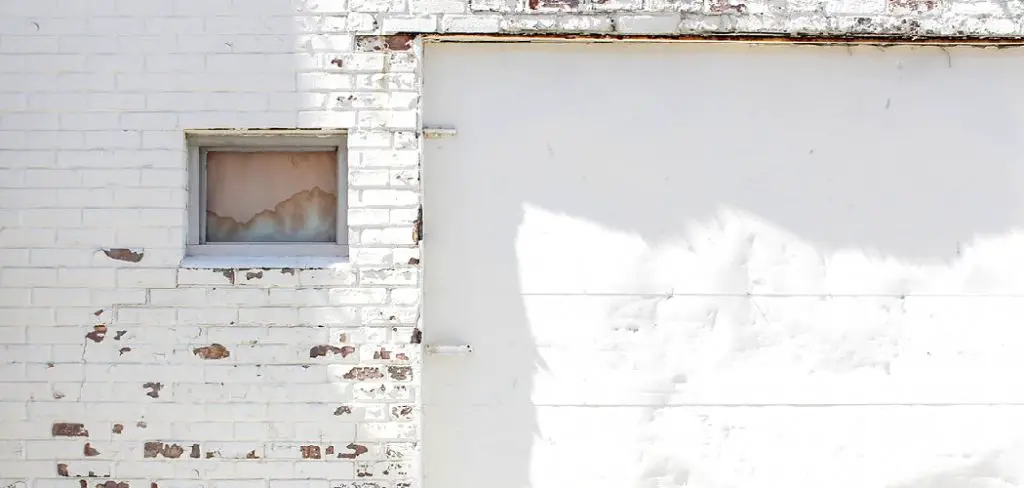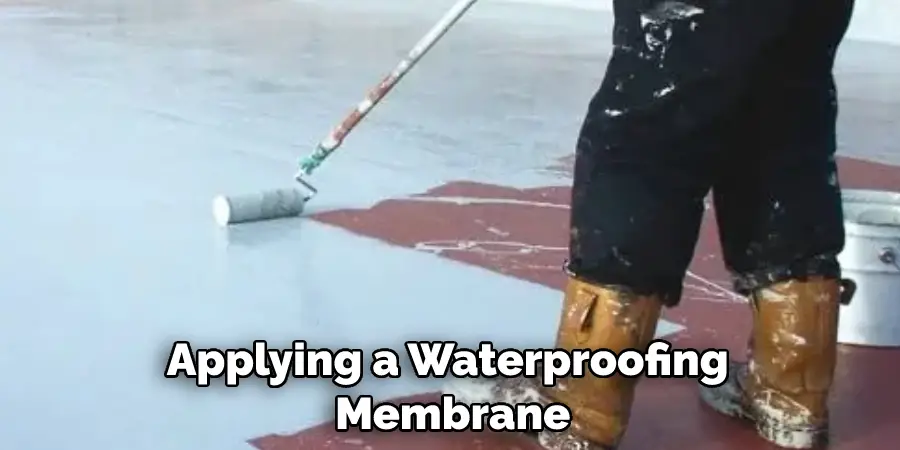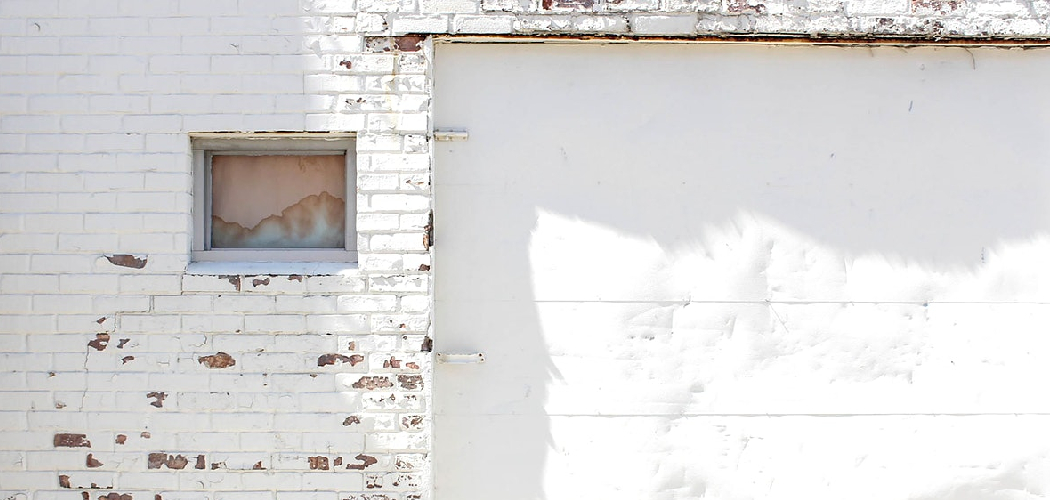If you have a garage, then you know that one of the annoying things about it is that water can come through the walls. In this post, we’ll show you how to stop water coming through garage wall. We’ll also give you tips on fixing the problem if it’s already happening. So, keep reading to find out more.

What Causes Water to Come Through Garage Walls?
There are a few different things that can cause water to come through your garage walls, including:
Cracks in the Foundation:
If there are cracks in your garage’s foundation, water can seep through them and into your garage. Therefore, it’s important to repair any cracks as soon as possible so they don’t get bigger and cause more damage.
Poor Drainage:
If your garage lacks proper drainage, water can build up around it and seep through the walls. This is especially a problem if you live in an area with heavy rain or snow.
Leaks:
If there are any leaks in your garage, then water can come through those as well. This could be from a leaky roof or pipes. Make sure to fix any leaks as soon as possible.
Humidity:
If your garage is very humid, then that can also cause water to come through the walls. This is because moisture will build up and eventually seep through. Humidity is often caused by not having enough ventilation in your garage.
Pressure Washers:
If you use a pressure washer to clean your garage, then that can also cause water to come through the walls. This is because the pressure from the washer can force water through any cracks or holes.
Tools You’ll Need
If you’re going to be fixing the problem yourself, then you’ll need a few tools, including:
A Hammer:
You’ll need a hammer to gently tap on the walls and locate areas where there may be weak spots or cracks.
A Chisel:
A chisel can help you widen any existing cracks so that you can properly fill them with sealant.
Sealant:
You’ll need some type of waterproof sealant to fill in any cracks or holes in your garage walls.
Caulk Gun:
A caulk gun will make it easier to apply the sealant in an even and controlled manner.
Paintbrush:
You’ll need a paintbrush to apply any waterproofing paint or sealant that may be necessary after you’ve filled in the cracks.
Step by Step How to Stop Water Coming Through Garage Wall:
1. Inspect the Foundation
The first thing you need to do is take a look at your garage’s foundation. Check for any cracks or holes that might be letting water in. If you find any, then you’ll need to repair them. If the cracks are small, you can use caulk to seal them up. For larger cracks, you’ll need to use a concrete patch. Make sure to follow the instructions on the patch and give it enough time to dry before moving on to the next step.
2. Check for Cracks in the Walls
Once you’ve checked the foundation, look at the walls themselves. Look for any cracks or holes that might be letting water in. Check both the inside and outside of the garage. If you find any cracks, seal them with caulk or another sealant. If the crack is larger, you may need to use a chisel to widen it before filling it with sealant.
3. Inspecting the Drainage
The next thing you need to do is take a look at your garage’s drainage. Make sure that the gutters are clear and that water can drain away from the garage. Also, check the downspouts to make sure that they’re not clogged. If necessary, you may need to add additional drainage around your garage to prevent water from building up.
4. Check for Leaks
Another thing you need to do is check for any leaks. This could be from a leaky roof or pipes. If you find any, then you’ll need to repair them as soon as possible. Leaky roofs are a common cause of water coming into garages. Fixing the leaks will not only stop water from coming in, but it will also prevent further damage to your garage and belongings. You may need to hire a professional for this step.
5. Improving Ventilation in Your Garage
One way to help reduce the amount of water that comes through your garage wall is to improve the ventilation in your garage. To fix this, you’ll need to improve the ventilation in your garage. You can add more fans or open the doors and windows when the weather permits. If you have an attached garage, you can also add a vent to the door leading into your house. This will help to circulate air and reduce humidity.
6. Using a Dehumidifier
If you have a problem with humidity in your garage, then you can also use a dehumidifier. This will help remove the air’s moisture and make your garage less humid. If you have a lot of moisture, then you may need to empty the dehumidifier often. You can also use a moisture-absorbing product like DampRid to help reduce humidity in your garage. It’s important to note that this may not completely solve the problem, but it can help reduce the amount of water that come through your walls.

7. Avoiding Pressure Washers
It is best to avoid using pressure washers as they can cause serious damage to your garage wall. This is because the pressure from the washer can force water through cracks or holes. To avoid this, use a lower pressure setting when cleaning your garage. If you need to use a pressure washer, then make sure to seal any cracks or holes first. The best way to prevent water from coming through your garage walls is to take preventative measures and regularly maintain your garage.
8. Cleaning Gutters and Downspouts
One way to help prevent water from coming through your garage wall is to clean your gutters and downspouts. This will help to ensure that water can drain away from your garage. If you have a lot of leaves and debris in your gutters, then you may need to hire a professional to clean them. It’s important to make sure your gutters and downspouts are clear and functioning properly to avoid any potential water damage.
9. Sealing Cracks in the Walls
If you find any cracks in your garage walls, then you’ll need to seal them. This will help to prevent water from coming through. To do this, you’ll need to use a crack sealer. You can purchase these at most hardware stores. Once you have your sealer, apply it to the cracks. Follow the instructions on the packaging for the best results. In most cases, you’ll need to apply a sealant layer and then wait for it to dry. Once it’s dry, you can apply a second layer, if necessary.
10. Applying a Waterproofing Membrane
If you’re still having problems with water coming through your garage wall, then you may need to apply a waterproofing membrane. This thin layer of material helps to block water from getting through. There are many different waterproofing membranes, so be sure to choose one that is right for your particular situation. Applying a waterproofing membrane is usually a two-person job. One person will need to hold the membrane in place while the other person applies it. Once the membrane is in place, you’ll need to use a brush or roller to smooth it out. Be sure to follow the manufacturer’s instructions carefully to apply the membrane correctly.
11. Installing a French Drain
If you have a serious problem with water coming through your garage wall, then you may need to install a French drain. This drainage system is installed around the perimeter of your garage, and it will collect any water that seeps through the wall and redirect it away from your home. You can install a French drain yourself or hire a professional to do it for you.
12. Hiring a Professional
If you’re still having problems with water coming through your garage wall, then you may need to hire a professional. They will be able to determine the cause of the problem and correct it. In most cases, they will also be able to install a waterproofing membrane or French drain. If you’re having trouble finding a professional, then you can ask your local building inspector for a recommendation.
Following these steps will not only help to prevent water from coming through your garage wall, but it will also ensure that your garage is a safe and dry space for storing your belongings. Remember to regularly maintain your garage and take preventative measures to avoid any potential water damage. So, keep an eye on the drainage, ventilation, and leaks in your garage to ensure its longevity.
Tips:
- Regularly inspect your garage for any leaks, cracks, or water buildup.
- Keep gutters and downspouts clean to prevent water from pooling near your garage.
- Use a dehumidifier or moisture-absorbing products to reduce humidity in your garage.
- Avoid using pressure washers on your garage walls.
- Seal any cracks in the walls with a crack sealer.
- Apply a waterproofing membrane if needed.
- Install a French drain for serious water issues.
- Consider hiring a professional for more complex problems.
- Regular maintenance and preventative measures are key to avoiding water damage in your garage.
- Be mindful of any changes in your garage’s drainage or ventilation and address any issues promptly to prevent further damage.
- Remember to always follow safety precautions when working on your garage, such as wearing protective gear and using caution with tools and equipment.
- Don’t hesitate to seek professional help if you are unsure how to handle a particular issue. Overall, taking care of your garage will not only protect your belongings, but also help to maintain the value and integrity of your property. So, don’t neglect your garage and ensure it stays dry and safe for years to come! Happy garaging!
Do You Need to Take Help From a Professional?
Knowing when to seek professional help is crucial in maintaining your garage. If you are unsure about the extent of the problem or how to fix it, it’s best to consult a professional. They will have the knowledge and experience to correctly assess and address any issues with your garage. Additionally, if you are not comfortable working with tools or heights, it’s important to prioritize your safety and hire a professional instead. Ultimately, investing in professional help can save you time, money, and stress in the long run.
So, don’t hesitate to seek assistance when needed! Remember, prevention is always better than dealing with costly repairs. Stay proactive and keep your garage safe and dry!
How Much Will It Cost?
The cost of preventing water from coming through your garage wall will vary depending on the severity of the problem and whether you choose to hire a professional or do it yourself. Simple tasks such as cleaning gutters and sealing cracks can be done at a minimal cost, but installing a French drain or waterproofing membrane may require a larger investment. However, keep in mind that these preventative measures can save you from potential costly repairs in the future. It’s also worth considering the value and safety of your belongings that are stored in the garage. Ultimately, investing in maintaining a dry and safe garage is an investment in the overall well-being of your home. So, why not make it a priority? Take action now and ensure your garage stays dry!
FAQ
How Much Does It Cost to Fix Water Coming Through a Garage Wall?
The cost of fixing water coming through a garage wall will vary depending on the cause of the problem. In most cases, you’ll need to seal the cracks and apply a waterproofing membrane. This can cost anywhere from $500 to $1,000. If you’re having a serious problem, then you may need to install a French drain. This can cost upwards of $2,000. Hiring a professional to fix the problem can also add to the cost. You’ll most likely need to pay an hourly rate for their services. The average cost of hiring a professional is $50 to $100 per hour.
Can White Cement Stop Water Leakage?
White cement can be used to stop water leakage in some cases. However, it’s not a permanent solution and will need to be reapplied regularly. In most cases, it’s best to use a sealant or another waterproofing method to stop water from leaking through your garage wall. If you decide to use white cement to stop a water leak, apply it evenly and allow it to dry completely before adding any additional layers. You may also need to reapply the cement after heavy rains or if the water leak is particularly severe.
Is It Better to Seal the Inside or Outside of a Garage Wall?
It’s usually best to seal the inside of a garage wall. This is because the inside of a garage wall is typically drier than the outside. Unfortunately, sealing the outside of a garage wall can trap moisture inside, leading to more serious problems like mold and mildew. If you seal the outside of your garage wall, be sure to use a breathable sealant that will allow any moisture trapped inside to escape. It’s always best to consult a professional before deciding whether to seal the inside or outside of your garage wall.
How Can I Prevent Water From Coming Through My Garage Wall?
There are several steps you can take to prevent water from coming through your garage wall. First, make sure that your gutters and downspouts are clean and directing water away from your garage. Second, seal any cracks or holes in the walls using a crack sealer. Third, consider applying a waterproofing membrane or installing a French drain if the problem persists.
Maintaining proper drainage and regularly checking for any cracks or holes can also help prevent water from coming through your garage wall. It is also important to monitor humidity levels in your garage and use a dehumidifier if necessary to reduce moisture levels. Finally, avoid using pressure washers on your garage walls as it can cause even more damage and potentially create new cracks for water to seep through.
Conclusion paragraph:
This article has presented a few different options for how to stop water coming through garage wall. So, there you have it. A few ways that you can control the water coming through your garage wall. All of these solutions are relatively easy and inexpensive to do. And, if you follow our tips, you should see a noticeable difference in the amount of water making its way into your garage. Have any questions or comments? Let us know in the comments section below.

